With the Baseline Landfill growing taller every day, our trash being hauled out of the county, and energy costs on the rise, why haven’t more of our residents embraced recycling? For that matter, why isn’t curbside recycling currently offered? Both good questions. Three local recycling experts shared their insight on this controversial issue and what the future may hold for Ocala and Marion County. Here’s what they had to say.
The statistics are astounding. America throws away enough office paper each year to build a 12-foot-high wall of paper from New York to Seattle. How about this one? Every three months, Americans landfill enough aluminum cans to re-build our entire commercial air fleet. Here’s another. Recycling one glass jar saves enough electricity to light a conventional 60-watt bulb for four hours.
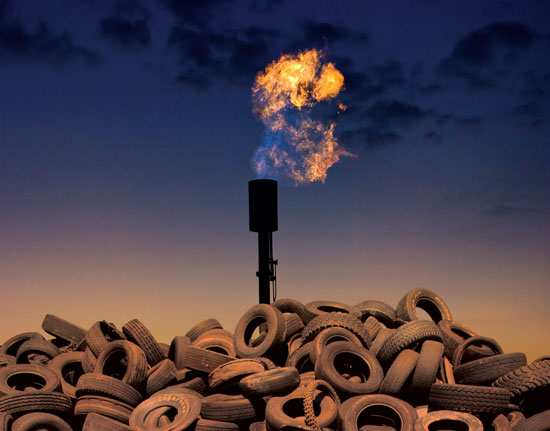
ETERNAL FLAME—Blue and gold flames of burning methane gas produced
by trash can be seen every evening licking the sky above the Baseline Landfill.
Photo illustration by Trevor Byrne. Photos by Steve Floethe
Recycling is big business. According to the Environmental Protection Agency, more than 82 million tons of recycled materials were processed in the U.S. in 2006. So why is it that only 22 percent of Marion County’s waste is being recycled, especially when the opportunity exists to re-use up to 90 percent of the materials we dispose of on a daily basis?
‘Trading One Service For Another’
We’ve all seen the brightly colored bins scattered throughout the city and county. These recycling centers (nine of them exist within city limits) have been in use for more than 10 years. Unfortunately, not enough people use them. On average, the city collects and recycles 1,700 tons annually from the bins. Those collected goods are then shipped to Ocala Recycling.
People cite a variety of reasons for not recycling—time, energy, and convenience. If John Zobler, the operations chief for the City of Ocala, gets his way, our hometown will implement curbside recycling to eliminate those excuses.
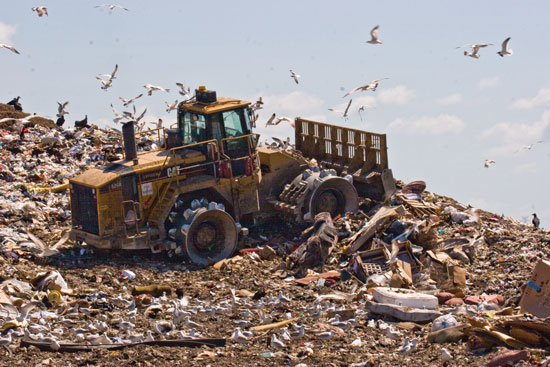
Baseline Landfill will reach its capacity in 5-10 years if action isn’t taken soon.
Lady Lake does it. So does Gainesville, Mount Dora, Tavares, even The Villages. So why doesn’t Ocala?
“The City of Ocala’s sanitation department has gone through a journey,” Zobler says. “Curbside recycling is the next logical step.”
Zobler notes that a city-wide questionnaire will be delivered to Ocala residents in the coming months to obtain a general consensus on a variety of topics, including sanitation and curbside recycling services.
He explains that one of the reasons Ocala doesn’t recycle on a mass scale is the expense. Each residential customer would have to pay an additional $2.50 to $4.50 a month in order to implement and maintain the service.
“I don’t want to raise prices,” Zobler says. “The only way we can add new services is by lowering our current operational expenses.”
So what’s his plan? It’s quite simple really.
“City residents have twice-a-week trash pick-up,” Zobler adds. “We’re seeing a large drop-off in the amount of trash we’re collecting on that second day. If we only pick up trash once a week, we can cut manpower in half, allowing us to implement curbside recycling. At the same time, our customer’s bills will not have to increase. We’d be trading one service for another.”
Of course, if Ocala does begin a curbside program, Zobler wants the right one. He says single-stream recycling, a system with no separation of recyclable goods, is the way to go. This is the program used by our neighbors to the south in Mount Dora, Tavares, and Lady Lake.
Doug McCoy, the district manager of Waste Management Inc. of Florida, holds the contract for Lady Lake’s curbside recycling program. The program is in its infancy but is already being considered a success.
“It’s more convenient for the homeowner and easier for the collector,” McCoy says. “A lot more material—junk mail, office paper, and cardboard—can be collected this way. It’s the first of its kind north of Orlando, aside from The Villages.”
Zobler hopes to initiate the same model for recycling here
in Ocala.
“Each customer would get one large 18-to 20-gallon recycling container and all of their recycled goods would be put into that one bin,” he says. “The goods would then be co-mingled and
sent to a dirty MRF [Materials Recovery Facility], where the waste would be electronically and manually sorted by magnets and optical scanners.
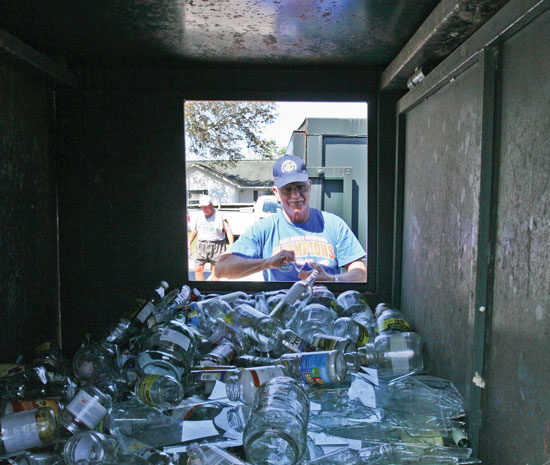
The convenience of curbside recycling would dramatically increase the recycling
efforts of Marion County residents. And it doesn’t have to cost a penny more
than current trash pickup.
“With curbside recycling, you’re looking at a higher level of convenience for our customers,” he concludes. “If recycling is made more convenient, more people will do it.”
‘A Lot Of Garbage’
Remember the big colorful recycling bins we mentioned earlier?
The City of Ocala and Marion County contract with Ocala Recycling to dispose of those recycled goods. This 34-acre facility recycles everything from bottles and paper to automobiles and washing machines. More than 16,000 tons of recycled goods are collected each month at Ocala Recycling.
For co-owner Rich Bianculli, the best way to increase Marion County’s recycling is to target local businesses. While Ocala Recycling is open to the public and an estimated 150 residents stop by to recycle each day, 80 percent of its business comes from commercial customers.
“The amount of office paper and cardboard disposed of daily is outrageous,” Bianculli says. “The office-type paper we recycle gets sent to a mill in North Carolina where it’s turned into
bath tissue.
“You’d be amazed at what’s recyclable,” he adds. “The average person produces 2.46 pounds of garbage each day. Multiply that times all the residents throughout Marion County and that’s a lot of garbage.”
Bianculli says to think of Ocala Recycling as an above-ground mine that excavates aluminum, steel, paper, glass, plastic, and other goods.
“We’re a manufacturer,” he says. “We produce the feedstock for mills and foundries. They need the raw materials for their furnaces or pulpers to create a new finished product.”
As a manufacturer, Ocala Recycling has to be price competitive, offering the mills the products they need at a rate that’s less expensive than harvesting natural, un-used materials. In the business world, cost per fiber unit is key.
“Glass, aluminum, and paper are a great way to get into recycling,” Bianculli suggests. “The only items we don’t accept are wood and tires.”
Bianculli credits Florida’s Solid Waste Management Act of 1988 for setting the state on the right track to recycling. But he believes that even more is possible.
“The government needs to mandate the manufacturing side,” he says. “Sure, we can recycle products, but what about all of the items that aren’t recyclable, like Styrofoam? We have to consider what our products are going to look like in the landfill in 20 years.”
‘Recycling Needs To Grow’
Dennis Slifer, the recycling coordinator and safety officer for the Marion County Solid Waste Department, has traveled throughout Marion County’s schools and businesses for more than four years, educating the public on the benefits of recycling.
According to Slifer, the Baseline Landfill will reach its capacity in 5-10 years if action isn’t taken soon.
“The county recently decided to build a waste–to–energy facility,” he says. “This process would minimize the impact of materials being landfilled and would convert normal household garbage into electricity, which then could be sold as green energy.
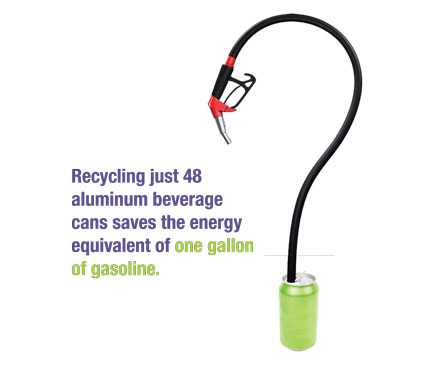
“There is currently talk in expanding,” Slifer adds. “That would give us another 14 acres and another 20 years.”
Slifer quickly emphasizes the main goal—to keep recyclables out of the landfill.
“We average 450 to 500 tons a day,” he says. “Statistics show that anywhere between 50 and 90 percent of that could be recycled and re-used. Unfortunately, it is often very expensive to achieve the highest recycling rates.”
Like the City of Ocala, Marion County operates a number of recycling centers throughout the county, 18 in all. Most of those recycled goods will eventually make their way to Ocala Recycling. Some will take a detour.
“The tires recycled at our facilities find their way to Global Tire Recycling in Wildwood,” Slifer says. “There, they grind them and enable them to be turned into a variety of products.”
The ground tires are then transformed into everything from playground matting and landscaping materials to modified asphalt and floor tiles. The applications are vast.
In another effort to save our natural resources, Slifer partnered with the Marion County Solid Waste Department in implementing a new program to convert methane gas into reusable energy.
“The project is under construction right now,” Slifer says. “The gases emitted at the landfill will be collected and produced into green energy and electricity by a company called G2 Energy out of Atlanta.”
G2 uses special engines to convert landfill gases into energy and sells it, in the form of generators, to regional utility companies. According to the G2 Web site, landfill-gas-to-energy embodies the ideal solution to an environmental problem—a nuisance waste is turned into a product with a practical use and economic value.
“In 10 to 20 years, that gas will still be there. Many landfills throughout the country are beginning to convert their gas to energy,” Slifer says. “But we still need our residents to do their part, though.”
What would Slifer like to see in the future?
“More construction and demolition products need to be recycled,” he says. “The amount of product thrown away on construction sites directly affects the disposal of valuable materials like wood and metal.
“Recycling will—and needs to—grow,” Slifer adds. “Our population continues to grow, which will only increase the amount of trash in our landfills.”
‘The Power Of Recycling’
“Recycling is relatively simple to do,” says Ron Henricks, administrator for waste reduction section at the Department of Environmental Protection. “Even if you don’t have curbside service, you can still drop off your goods at any of the drop-off points. Just as important as recycling, though, is consciously buying recycled goods. This closes the circle.”
In the past, recycling was touted as a way to conserve energy. Despite rising gas and oil prices, that’s still true today. Environmental concerns and global warming are just as, if not more, important than ever before.
“One person may not have a huge impact, but a lot of people doing little things have a cumulative impact on our environment,” says Henricks. “That’s the power of recycling.”
Sources: The National Recycling Coalition, earth911.org, The Florida Department of Environmental Protection
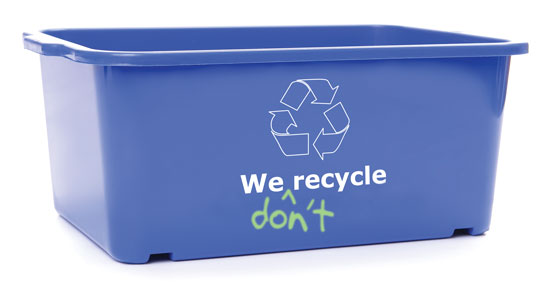
How We Stack Up On Recycling
By Kristina Kolesa
All counties are not created equal when it comes to recycling habits. In our large, populous state, each county handles waste management with its own rules and procedures, and the numbers reflect the result. Take a look at the latest available data from the Florida Department of Environmental Protection on how Marion County stacks up against Alachua and Lake (our neighboring counties to the north and south), Osceola (the county closest in size to our own), and Manatee (the county closest in population).
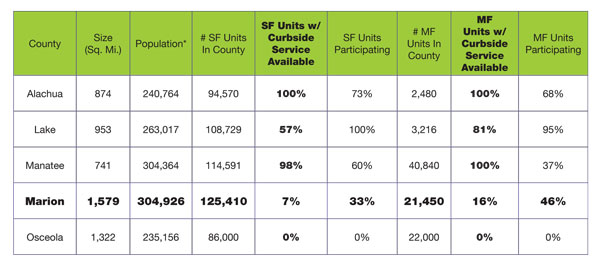
(SF) single-family dwellings
(MF) multi-family dwellings
* Official 2004 Governor’s Office estimates
Sources: Florida Department of Environmental Protection, 2005 Solid Waste Annual Report (dep.state.fl.us/waste). National Association of Counties.
The Big 5:
What you probably didn’t know about recycling.
1. PAPER
Making paper from recycled paper reduces contributions to air pollution by 95%.
Recycling a stack of newspaper just three feet high saves ONE tree.
2. ALUMINUM
Recycling 1 aluminum can saves enough energy to power a TV for 3 hours.
Aluminum is a durable and sustainable metal: 2/3 of the aluminum ever produced is still in use today.
3. PLASTIC
The plastic recycling industry provides jobs for more than 52,000 American workers.
Five PET bottles (plastic soda bottles) yield enough fiber to produce one extra large T-shirt, one square foot of carpet, or enough fiber fill for one ski jacket.
4. GLASS
Glass can be recycled an indefinite number of times and never wears out.
Recycling 1 glass jar saves enough electricity to light a conventional 60-watt bulb for four hours.
5. STEEL/TIN CANS
The steel industry has been recycling for over 150 years. Americans use 100 million steel cans every day.
Do Your Part
For a complete list of local recycling centers, visit www.ocalarecycling.com






